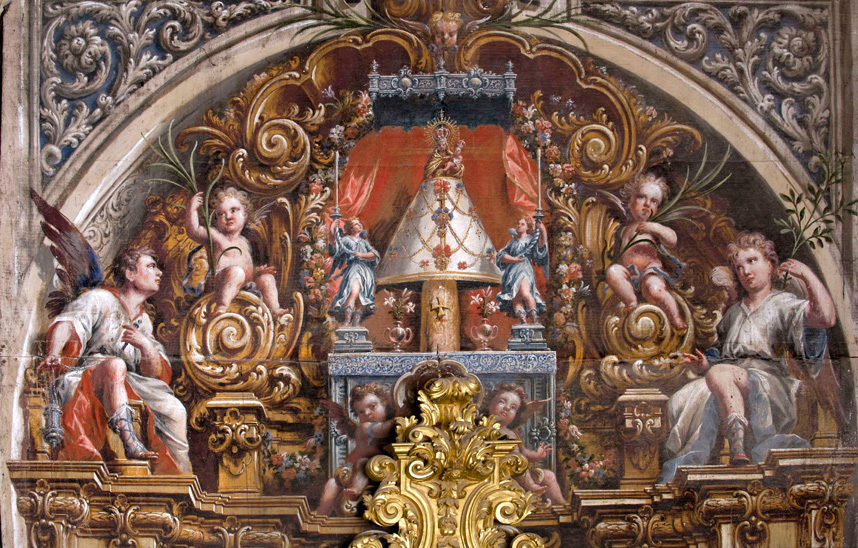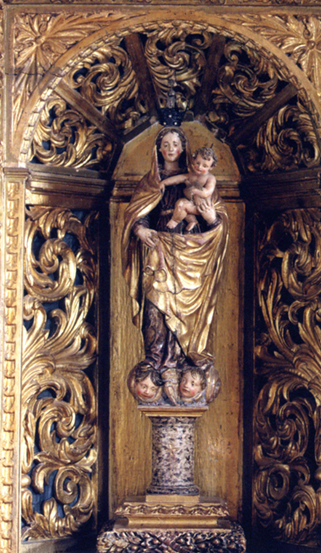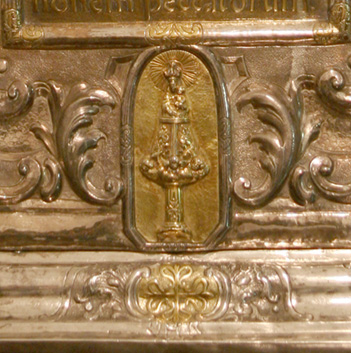The Virgin of Pilar in Navarra

PhotoJ. L. Larrión/tico of a mock altarpiece depicting the Virgin of Pilar in San Francisco de Viana, by Francisco del Plano, c. 1715-1720.
The devotion to the Virgin of Pilar in Navarre is multi-secular and more evident since the miraculous events of the seventeenth century. The miracle of Calanda (1640) and her board of trustees over Zaragoza (1642) and Aragon (1678) were events that did not go unnoticed in Navarre. In addition, it should be noted that the image of Zaragoza is a sculpture of French-Burgundian Gothic style from around 1435, attributed to the Daroca sculptor Juan de la Huerta, which was probably donated by Dalmacio de Mur, with the patronage of Doña Blanca of Navarra, wife of Juan II of Aragon, following the cure of an illness that had afflicted the queen at that time.
Hermitages, altarpieces, wooden and alabaster images, paintings on panel or canvas, prints, measures, agnus and other objects of popular veneration are faithful testimonies that tell us about devotions, traditions and promoters. In a very particular way it is necessary to mention the Pilarist brotherhoods in Navarre. Gregorio Silanes, in his study, gathers the existing ones at the end of the XVIII century, located in Pamplona, Tafalla, Sangüesa, Falces, Arróniz and Lerín.

Shrine of Our Lady of Fair Love of the Virgin of Pilar in Ciga
With respect to the hermitages of their ownership, those of Urzante, Lecumberri and those of the lands of Baztanes stand out, where there are hardly any local Marian dedications, as in the rest of Navarre. The hermitages of Garzain -rebuilt in 1816- and Maya, very reformed in 1879, as well as the one located in the manor of Egozcue, in Ciga, give a good account of the Pilarist fervor in the Valley.
A Shrine of Our Lady of Fair Love with a special cult was that of the Virgen del Pilar del Puerto de Osquía in Atondo, erected in 1570 by Pedro Atondo. Curiously, and in spite of bearing the invocation of the Pilar, the engravings of the image do not present any of the iconographic characteristics of the icon from Zaragoza.
The iconographic subject
In the internship totality of the examples of Pilarist representations, the famous Zaragozan prototype is followed, in which Mary appears erect on the column and pedestal of angels. She appears as Queen and Mother, crowned, with a regal gothic dress of subject of great modesty, buttoned from the waist and with the neck raised and also buttoned. The long robe or tunic is girded with a belt and reveals her shoes at the bottom. A large cloak serves as a cape and envelops the figure while serving as a headdress. With the right hand she holds a wide fold and with the left the Child, who also rests on her mother's hip and arm. The Child Jesus appears naked and holds a bird, perhaps the symbolic dove of divinity or the human soul.

Altarpiece of the Virgin of Pilar in the parish of Arróniz, work of the Sesma sculptor Ramón Villodas. 1774. Photo G. Martínez Laparra
Pilarist iconography spread in the visual arts through the aforementioned archetype of the basilica to which we have just referred and the miracles of the Virgin, especially that of the Coming -topic fixed from the end of the 15th century in the fundamentals and later recreated with numerous variants - and that of Calanda. It must be taken into account that the topic of the Coming would come to be represented not only in painting and sculpture in the lands of the Hispanic monarchy, but also in the reverses of the waxed Agnus Dei, such as those of Innocent XIII and Clement XII, in 1722 and 1737, respectively.
The column or pillar of jasper, frequently adorned with a cross, is its main element of iconographic identification. On numerous occasions the image will appear with the traditional mantle that is changed daily and placed at a greater or lesser height and covered with more or less jewels, leaving the Child and even the image visible. In this respect, it is necessary to remember that in an inventory of 1577 seventy-two mantles were counted and that even being a habitual garment in the vestment images, in the case of the Pilar it possesses the peculiarity of its cut and disposition between the relic of the column and the prototype image, characteristics both that turned it into a sign of identity of the iconography of the Pilarists. Another allusion almost always present in the engraved, painted reproductions or other techniques of multiplication of the images is the dressing room, with the celestial evocation to which the angels cooperate.

Table of the coming of the Virgin of Pilar in the main altarpiece of Inza, work of the Oscáriz workshop of the 16th century. Photo M. J. Tarifa
In the capital of Navarre
Pamplona has had and still preserves a good collection of Pilarist iconography. The last century has been marked, among the devotees of the Virgin of the Pilar, by the reproduction in marbles of the Holy Chapel of Zaragoza, which is located in the parish of San Nicolás (1912). However, the Pilarist cult in the aforementioned temple had several milestones over the centuries. Among them is the construction of the primitive altarpiece in 1675 by Miguel de Bengoechea, commissioned by a Navarrese resident in the Aragonese capital, Miguel de Labiano. The altarpiece can be identified with the current one of the Heart of Jesus, due to the style and the presence in the attic of St. Peter Arbués -by the way, converted into St. Raymond Nonnatus in a more than debatable intervention-, as specified in the contract for the work. The reason for Bengoechea's having received this commission must be related to his stays in Zaragoza, linked to the royal works.

Image of the Virgin of the Pilar from the second quarter of the 17th century in the Poor Clares of Tudela. It comes from the convent of Fitero where it had come from Calatayud.
In the chapter sacristy of the cathedral there is a silver image of the Virgin of Pilar, kept in one of the rococo niches of the complex. Next to the image is preserved a piece of earth from the place of the apparition of the Virgin in Zaragoza.
In the choir loft of the Augustinian Recollect nuns hangs a painting on a delicate curly wood framework from the middle of the 17th century. In the chapterhouse conference room of the same convent there is a sculpture of the Virgin of Pilar, a gift of the Count of Grajal to the community, on the occasion of the visit of Philip IV to Pamplona. In the inventory of 1647 it is noted as follows: "an image of sculpture of Our Lady of the Pillar of Zaragoza, which the Count of Grajal sent us, in gratitude for having lodged him in the room when His Majesty was in this city".
In the parish of San Lorenzo and in an attic of a collateral of the Carmelitas, images of the Virgin of Pilar can also be contemplated.
The devotion of the people of Pamplona and Navarre increased thanks to the numerous pilgrimages to the Pilar de Zaragoza, celebrated with great pomp and even with hymns specially composed for the occasion. The bulletin of the Diocese gives an account of those of 1880, 1904, 1906, 1908, 1912, 1916, 1920, 1922, 1923, 1924, 1928...etc.
Images and altarpieces, canvases and reliefs of the Apparition of St. James
Altarpieces dedicated to the Virgin of the Pilar, with historical ownership, have had temples in Pamplona, Tudela, Arróniz, Cirauqui, Estella, Lerín, Otiñano, Artajona, Santacara, Navascués, Sangüesa, Uztárroz, Lacunza, Cascante, Cortes and Valtierra. The monastery of La Oliva also had an altarpiece, a work that Madrazo attributes to Ramos Benavides or Manuel Guiral. In other churches, some altarpieces previously dedicated to other saints were placed under their ownership, generally with new images from Olot.

Detail of the Benedictine nuns of Estella, made in Zaragoza by Antonio Lastrada, 1744.
In the lands of Navarre, so closely linked to the Camino de Santiago, the scene of the apparition of the Virgin to the apostle can be found in different localities. Of particular importance for its chronology is a panel of the Renaissance altarpiece of the parish of Intza that represents the Coming of the Virgin to Zaragoza. Recently, María José Tarifa has studied the whole, attributing it to the workshop of the Oscáriz family, and she has also studied the importance of the aforementioned panel, pointing out engraved sources that could have inspired it. A little earlier in time, in the middle of the 16th century, a polychrome alabaster relief preserved in a private collection in Tudela should be dated.
In the parish church of Santiago de Puente la Reina we find the passage of the Coming of the Virgin for obvious reasons related to the apostle. Its author was Francisco Sainz de Barahona, who in 1742 undertook to carve two stories for the bench of the aforementioned altarpiece, one with the Coming of the Pillar and the other with the Degollation of the apostle, as well as other sculptures.
In Corella two canvases represent the passage, one preserved in the Arrese Museum and the other in the altarpiece of the Virgen del Amor Hermoso in the parish of San Miguel. In Viana there is a beautiful late-Romanesque relief by the sculptor Juan de Bazcardo in the altarpiece of the Crucifixion. In Arróniz, where the Virgen del Pilar has its own rococo altarpiece, there is a relief of the apparition in the altarpiece of the Virgen del Rosario. In the Conceptionists of Estella there is a large eighteenth-century canvas with the same topic of great apparatus.
Images of special quality are preserved in Cortes, Arróniz or Tudela. The first of these is, as we know, a work made around 1500 in Mechelen in Brabant, an important center of production and exportation during the second half of the 15th century and the first decades of the 16th century. Around this image, there is a pious tradition that related it to a donation on the return of Queen Blanca from a pilgrimage to the sanctuary of El Pilar in Zaragoza in 1433. The one of Arróniz is characterized by the dynamism of its mantle and among those preserved in Tudela, we will highlight for its delicacy the one of the Poor Clares, previously in the convent of Fitero and before that in the Poor Clares of Calatayud.
Also, some silver images and reliefs stand out. Among them we will emphasize the one that decorates the knot of the monstrance of Urroz-Villa and the one that is in an elegant sacra of the Benedictines of Estella, work of the silversmith from Zaragoza Antonio Lastrada (1744).
In the church of the Franciscans of Viana an image painted by Francisco del Plano is preserved within the set of altarpieces of perspective or trompe l'oeil, which happen to be a unique set of its kind in the Comunidad Foral.
As far as votive offerings are concerned, the parish of Lerín has one that refers to the miracle worked in the person of Pedro Ibiricu who witnessed the bullfighting in that town from the tower on the day of the Virgen del Pilar, falling from a height of "onehundred and five feet" and remaining unharmed, in 1709.
